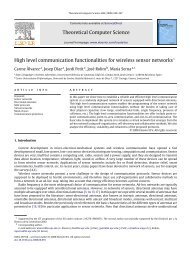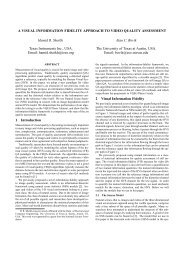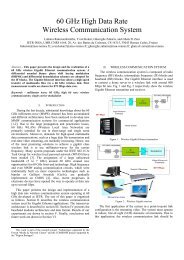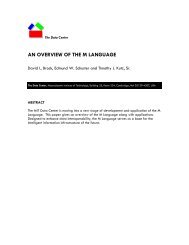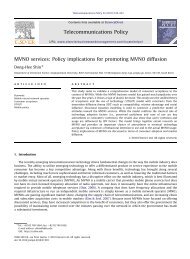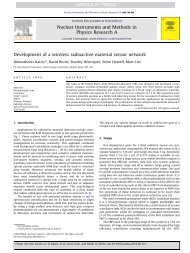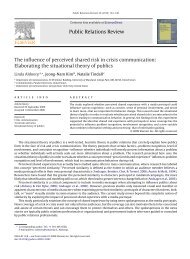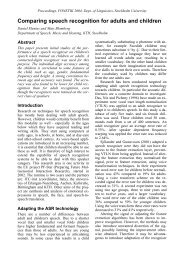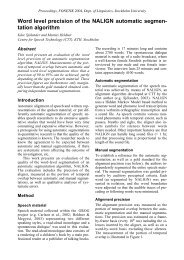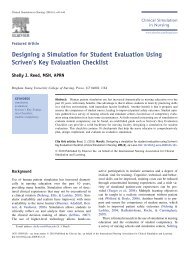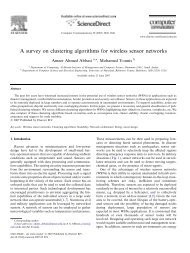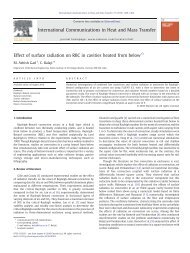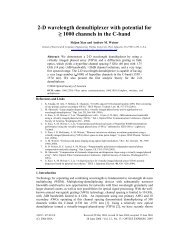Demonstration of single channel 160-Gb/s OTDM 100-km ...
Demonstration of single channel 160-Gb/s OTDM 100-km ...
Demonstration of single channel 160-Gb/s OTDM 100-km ...
Create successful ePaper yourself
Turn your PDF publications into a flip-book with our unique Google optimized e-Paper software.
<strong>Demonstration</strong> <strong>of</strong> <strong>single</strong> <strong>channel</strong> <strong>160</strong>-<strong>Gb</strong>/s <strong>OTDM</strong> <strong>100</strong>-<strong>km</strong> transmission system<br />
Tao-rong Gong *, Feng-ping Yan, Dan Lu, Ming Chen, Peng Liu, Pei-lin Tao,<br />
Mu-guang Wang, Tang-jun Li, Shui-sheng Jian<br />
Key-Laboratory <strong>of</strong> All-Optical Networks and Advanced Communication Networks, Ministry <strong>of</strong> Education, Beijing <strong>100</strong>044, China<br />
Institute <strong>of</strong> Light Wave Technology, Beijing Jiaotong University, Beijing <strong>100</strong>044, China<br />
article info<br />
Article history:<br />
Received 15 April 2009<br />
Received in revised form 19 May 2009<br />
Accepted 19 May 2009<br />
PACS:<br />
07.60<br />
42.72<br />
42.79<br />
85.60<br />
42.88<br />
42.15<br />
Keywords:<br />
Optical communication<br />
<strong>OTDM</strong><br />
Transmission<br />
1. Introduction<br />
abstract<br />
With the ever-increasing demand in communication bandwidth<br />
and the maturity <strong>of</strong> wavelength-division-multiplexing (WDM),<br />
Optical time-division-multiplexing (<strong>OTDM</strong>) is another important<br />
technique to overcome the electronic bottleneck and achieve <strong>single</strong><br />
<strong>channel</strong> high bit-rate system. Since the first <strong>100</strong>-<strong>Gb</strong>/s <strong>OTDM</strong> transmission<br />
experiment over a 36-<strong>km</strong> fiber link was already reported<br />
in 1993 [1], <strong>OTDM</strong> technologies have made a lot <strong>of</strong> progress toward<br />
much higher bit rates and much longer transmission distance [2–<br />
4]. For example, <strong>160</strong>-<strong>Gb</strong>/s transmission over a record length <strong>of</strong><br />
4320 <strong>km</strong> [5] and on 2.56-Tb/s transmission over <strong>160</strong>-<strong>km</strong> have been<br />
reported [6].<br />
An <strong>OTDM</strong> system consists <strong>of</strong> the following key sub-systems:<br />
ultra-short pulse generator, <strong>OTDM</strong> multiplexer, tributary clock<br />
extraction and high-speed optical switch to perform demultiplexing.<br />
There are several optical-signal-processing technologies avail-<br />
* Corresponding author. Address: Institute <strong>of</strong> Light wave Technology, Beijing<br />
Jiaotong University, Beijing <strong>100</strong>044, China. Tel.: +86 10 51684015/13426062162.<br />
E-mail addresses: trgong2009@gmail.com (T.-r. Gong), fpyan@bjtu.edu.cn (F.-p.<br />
Yan), danlucy@gmail.com (D. Lu), 05111023@bjtu.edu.cn (M. Chen), 0611<strong>100</strong>3<br />
@bjtu.edu.cn (P. Liu), 06120248@bjtu.edu.cn (P.-l. Tao), mwgang@center.njtu.edu.<br />
cn (M.-g. Wang), tjli@bjtu.edu.cn (T.-j. Li), ssjian@bjtu.edu.cn (S.-s. Jian).<br />
0030-4018/$ - see front matter Ó 2009 Elsevier B.V. All rights reserved.<br />
doi:10.1016/j.optcom.2009.05.060<br />
Optics Communications 282 (2009) 3460–3463<br />
Contents lists available at ScienceDirect<br />
Optics Communications<br />
journal homepage: www.elsevier.com/locate/optcom<br />
A16 10-<strong>Gb</strong>/s optical time-division-multiplexing (<strong>OTDM</strong>) <strong>100</strong>-<strong>km</strong> transmission system with homemade<br />
multiplexer is demonstrated experimentally. A demultiplexer based on two cascaded electroabsorption<br />
modulator (EAM) and a clock recovery unit form a feedback loop. Error-free demultiplexing<br />
from <strong>160</strong>-<strong>Gb</strong>/s to 10-<strong>Gb</strong>/s after over <strong>100</strong>-<strong>km</strong> transmission is achieved. The power penalty is about<br />
3.5 dB with the bit error rate <strong>of</strong> 10 9 .<br />
Ó 2009 Elsevier B.V. All rights reserved.<br />
able for each part, and EAM is one <strong>of</strong> the optimum terminal<br />
equipments as optical gate and a clock recovery device in the receiver<br />
[4]. In this paper, a 16 10-<strong>Gb</strong>/s <strong>OTDM</strong> <strong>100</strong>-<strong>km</strong> transmission<br />
system is demonstrated experimentally based on mode-locked fiber<br />
lasers (MLFL) and home-made multiplexer in the transmitter<br />
and EAM in the receiver.<br />
2. Transmission systems<br />
Fig. 1 shows the experimental setup, which consists <strong>of</strong> three<br />
parts: transmitter, transmission link and receiver. The following<br />
will describe the three parts in detail.<br />
2.1. Transmitter<br />
The solid box <strong>of</strong> Fig. 1 shows the setup <strong>of</strong> <strong>160</strong>-<strong>Gb</strong>/s transmitter.<br />
It comprises MLFL (CALMAR OPTCOM Model: PSL-10-1T), a<br />
modulator and a passive multiplexer. The MLFL generated a pulse<br />
train with a repetition rate <strong>of</strong> 10 GHz (9.95328 GHz) at a wavelength<br />
<strong>of</strong> 1556.223 nm. The emitted pulses are the shape <strong>of</strong> a<br />
sech 2 -function and a full-width at half-maximum (FWHM) <strong>of</strong> less<br />
than 1.5 ps. The 10 GHz pulse train is intensity modulated with a
pseudo random bit-sequence (PRBS 2 7<br />
1) by an external LiNbO3<br />
modulator. Then the 10-<strong>Gb</strong>/s data signal is multiplexed to <strong>160</strong>-<br />
<strong>Gb</strong>/s by a home-made multiplexer.<br />
Conventional <strong>OTDM</strong> multiplexer is based on fused fiber coupler<br />
and its performance is usually degraded due to polarization fluctuation<br />
<strong>of</strong> the input signal, which will rapidly change the distribution<br />
<strong>of</strong> output power among adjacent multiplexed pulses [7,8]. Recently<br />
reported <strong>OTDM</strong> multiplexers [9,10] can provide qualified and stable<br />
<strong>OTDM</strong> signals but is not widely used in practice due to their<br />
high cost. In this work we propose a cost-effective and low polarization<br />
dependent structure to achieve the multiplexing. The<br />
home-made multiplexer consists <strong>of</strong> four-stage <strong>OTDM</strong> multiplexer<br />
based on plated graded index (GRIN)lens, which consists <strong>of</strong> two reverse-connected<br />
GRIN lenses coupled with three fiber pigtails and<br />
performs the same function as fused fiber coupler. A very thin Half-<br />
Reflection-Half-Transmittance (HRHT) mirror is plated between<br />
two lenses, as shown in Fig. 2. This structure based on GRIN lens<br />
exhibits low polarization dependence [11].<br />
Two plated GRIN lenses aforementioned compose one stage<br />
multiplexer, as illustrated in Fig. 3. Ports 3 and 3 0 are coupled directly<br />
and a fiber delay line is added between Ports 2 and 2 0 . Then<br />
the signal at Port 1 is doubled and multiplexed at Port 1 0 . Our 4stage<br />
multiplexer consists <strong>of</strong> 4 pairs <strong>of</strong> such cascaded lenses. The<br />
delay times in each stage are 50 ps, 25 ps, 12.5 ps and 6.25 ps,<br />
respectively. The insertion loss <strong>of</strong> each stage is about 4.5 dB and<br />
thus the total insertion loss <strong>of</strong> the 4-stage MUX is about 18 dB.<br />
2.2. Transmission link<br />
The dashed box <strong>of</strong> Fig. 1 shows the setup <strong>of</strong> the transmission<br />
link. The total length <strong>of</strong> fiber is <strong>100</strong> <strong>km</strong> which is composed by<br />
90 <strong>km</strong> SMF and 10 <strong>km</strong> dispersion slope compensation (DSCF)<br />
(both fabricated by Yangtze Optical Fiber and Cable Com.:YOFC).<br />
T.-r. Gong et al. / Optics Communications 282 (2009) 3460–3463 3461<br />
Fig. 1. Experimental setup.<br />
The insertion loss <strong>of</strong> DSCF is 6.89 dB, and total insertion loss <strong>of</strong> fiber<br />
span is 29 dB including all splices and connectors. The DSCF is designed<br />
to achieve both zero chromatic dispersion and slop at<br />
1550 nm wavelength band for 90 <strong>km</strong> SMF. Delay and the dispersion<br />
<strong>of</strong> DCF are measured by CD400 as indicated in Fig. 4. At<br />
1556.223 nm the dispersion and slope values are 150.432 ps/<br />
nm/<strong>km</strong> and 4.931 ps/nm 2 /<strong>km</strong>, respectively, for DSCF and<br />
16.723 ps/nm/<strong>km</strong> and 0.058 ps/nm 2 /<strong>km</strong>, respectively, for SMF.<br />
The DSCF is placed in the middle <strong>of</strong> the transmission link, which<br />
has been shown to be better than pre-dispersion and post-dispersion<br />
compensation schemes [12].<br />
For <strong>160</strong>-<strong>Gb</strong>/s transmission system the chromatic dispersion tolerance<br />
is found to be +/ 50 m for SMF [13]. In order to compensate<br />
the dispersion and slope well, different length <strong>of</strong> SMF is added at<br />
the last span fiber to obtain best compensation, such as 50 m,<br />
<strong>100</strong> m, 150 m, 200 m, and 300 m. As the bandwidth <strong>of</strong> our oscilloscope<br />
(Agilent DCA 86<strong>100</strong> B) is only 53 GHz, we observe the waveform<br />
change <strong>of</strong> 10 GHz pulse source to validate. The RMS width <strong>of</strong><br />
measured pulse source after transmission with the added fiber<br />
length for 300 m, 200 + 50 m and 300 m + 50 m are 9.20 ps,<br />
9.58 ps and 9.62 ps, respectively. Although the resolution <strong>of</strong> our<br />
oscilloscope is limited, those measured values can give us a qualitative<br />
evaluation <strong>of</strong> the compensation performance. Compared to<br />
other configurations, the three combinations are better. Also the<br />
300 m fiber is the best. The PMD <strong>of</strong> SMF is less than 0.05 ps/<strong>km</strong> 1/2 ,<br />
and the PMD <strong>of</strong> SDCF is 0.29 ps provided by YOFC, so the total<br />
PMD <strong>of</strong> transmission link is less than 0.76 ps which is sufficiently<br />
small for <strong>160</strong>-<strong>Gb</strong>/s data transmission [4].<br />
Fig. 2. Structure <strong>of</strong> the plated GRIN lens and the inner optical paths. Fig. 3. Structure <strong>of</strong> SMUX based on plated GRIN lens.
3462 T.-r. Gong et al. / Optics Communications 282 (2009) 3460–3463<br />
2.3. Receiver<br />
The dash-dotted box <strong>of</strong> Fig. 1 shows the schematic <strong>of</strong> the receiver,<br />
which consists <strong>of</strong> two cascaded EAMs and 10-<strong>Gb</strong>it/s clock and<br />
data recovery unit (CDRU). Two EAMs are concatenated to achieve<br />
a switching window <strong>of</strong> less than 5 ps with a suppression ratio <strong>of</strong><br />
larger than 20 dB, similar to that described in [3,14]. The first<br />
EAM exhibits 7 dB polarization sensitivity and is driven at<br />
10 GHz, and the second EAM is polarization independent and is<br />
driven at 40 GHz. So a polarization controller (PC) is used to change<br />
the polarization state <strong>of</strong> optical signal input EAM1. CDRU is based<br />
on opt-electronic phase-locked loop (PLL) and can exact the<br />
10 GHz clock and 10-<strong>Gb</strong>/s electrical data from the 10-<strong>Gb</strong>/s optical<br />
signal. After passing through these two EAMs the <strong>160</strong>-<strong>Gb</strong>/s signal<br />
Fig. 5. Eye diagram <strong>of</strong> (a) 10-<strong>Gb</strong>/s modulated signal and (b) demultiplexed 10-<strong>Gb</strong>/s<br />
signal from <strong>160</strong>-<strong>Gb</strong>/s <strong>100</strong>-<strong>km</strong> transmission.<br />
Fig. 4. Dispersion curve <strong>of</strong> special DSCF.<br />
is demultiplexed to 10-<strong>Gb</strong>/s signal. Then 10-<strong>Gb</strong>/s optical is divided<br />
into two parts by a 25:75 coupler. One part is used for observation<br />
on the DCA, and the other part is injected into the CDRU. The electrical<br />
10 GHz clock signal extracted by CDRU is fed into the electrical<br />
input <strong>of</strong> the EAMs, and the two EAMs and the CDRU form a<br />
demultiplexing and clock recovery loop. By using this structure<br />
two EAMs are saved compared to similar experimental set-up<br />
[3,14].<br />
3. Experiment results<br />
The input optical power <strong>of</strong> transmission is 5 dBm. The receiver<br />
sensitivity is defined at the input power <strong>of</strong> CDRU. By adjusting<br />
the variable electrical delay and the bias <strong>of</strong> the EASW1 and EASW2<br />
carefully, the error-free demultiplexing is achieved. The bias voltage<br />
<strong>of</strong> EASW1 and EASW2 is 1.9 V and 1.22 V, respectively,<br />
which are the same to the case <strong>of</strong> <strong>160</strong>-<strong>Gb</strong>/s back-to-back (B2B)<br />
demultiplexing. Fig. 4b shows the eye diagram <strong>of</strong> 10-<strong>Gb</strong>/s demultiplexing<br />
signal. Compared to Fig. 5a, it has larger noise and jitter. The<br />
mean values <strong>of</strong> jitter <strong>of</strong> modulated signal and demultiplexed signal<br />
are 847 fs and 962 fs measured by DCA, respectively. Due to the resolution<br />
<strong>of</strong> our oscilloscope is limited those measured values only<br />
give us a qualitative evaluation. But the eye diagram is clear and<br />
open, and the non-target <strong>channel</strong> is suppressed sufficiently.<br />
BER<br />
1E-4<br />
1E-5<br />
1E-6<br />
1E-7<br />
1E-8<br />
1E-9<br />
1E-10<br />
B2B<br />
transmission<br />
1E-11<br />
-19.5 -19.0 -18.5 -18.0 -17.5 -17.0 -16.5 -16.0 -15.5 -15.0<br />
Power /dBm<br />
Fig. 6. BER measurement <strong>of</strong> <strong>160</strong>-to-10 <strong>Gb</strong>/s.
Fig. 6 depicts the BER performance curves <strong>of</strong> a random demultiplexing<br />
<strong>channel</strong> from <strong>160</strong>-<strong>Gb</strong>/s signal <strong>of</strong> B2B and transmission<br />
over <strong>100</strong>-<strong>km</strong>. The receive sensitivity (BER = 10 9 ) measured after<br />
transmission is 15.25 dBm. Similar BER performance is obtained<br />
for the other <strong>channel</strong>s, and the difference in sensitivity among<br />
<strong>channel</strong>s is less than 0.8 dB. A 3.5 dB power penalty is observed<br />
after <strong>100</strong> <strong>km</strong> transmission. Compared to similar experiment<br />
[3,14], the power penalty is 1 dB larger. Except for the PMD effect<br />
and different type pulse source, the power penalty may be attributed<br />
to the following reasons: remnant dispersion, wide sampling<br />
window and rather large insertion loss <strong>of</strong> EAM, and ASE noise <strong>of</strong><br />
home-made EDFA.<br />
4. Conclusions<br />
A <strong>single</strong> <strong>channel</strong> <strong>160</strong>-<strong>Gb</strong>/s transmission over <strong>100</strong>-<strong>km</strong> is reported<br />
using home-made multiplexer. And the 10-<strong>Gb</strong>/s error-free<br />
demultiplexing from <strong>160</strong>-<strong>Gb</strong>/s based on a feedback loop composed<br />
by two cascaded EASW and CDRU is obtained after <strong>100</strong>-<strong>km</strong> transmission.<br />
Compared to the B2B case, the power penalty is 3.5 dB at<br />
the BER <strong>of</strong> 10 9 .<br />
T.-r. Gong et al. / Optics Communications 282 (2009) 3460–3463 3463<br />
Acknowledgement<br />
This work was supported by National Science Foundations <strong>of</strong><br />
Beijing (No. 4062027) and National 863 High Technology Projects<br />
<strong>of</strong> China (No. 2007AA01Z258, 2008AA01Z15) and National Natural<br />
Science Foundation <strong>of</strong> China (No. 60877042, 60837002).<br />
References<br />
[1] S. Kawanishi, H. Takara, K. Uchiyama, et al., in: Proc. ECOC, 1993, p. 53.<br />
[2] M. Saruwatari, IEEE J. Quantum Electron. 6 (2000) 1363.<br />
[3] B. Mikkelsen, G. Raybon, R.-J. Essiambre, in: Proc. ECOC, 2000, p. 6.1.1.<br />
[4] H. Weber, R. Ludwig, S. Ferber, et al., J. Lightwave Technol. 24 (2006) 4616.<br />
[5] S. Weisser, S. Ferber, L. Raddatz, et al., Photon. Technol. Lett. 18 (2006) 1320.<br />
[6] H.G. Weber, S. Ferber, M. Kroh, et al., Electron. Lett. 42 (2006) 178.<br />
[7] K. Morishita, K. Takashina, J. Lightwave Technol. 9 (1991) 1503.<br />
[8] Z. Jing, L. Cai, T. Li, J. Photon Technol. 8 (2005) 18.<br />
[9] H. Murai, M. Kagawa, H. Tsuji, K. Fujii, IEEE J. Quantum Electron. 13 (2007) 70.<br />
[10] T. Ohara, H. Takara, I. Shake, et al., IEEE J. Quantum Electron. 13 (2007) 40.<br />
[11] M. Born, E. Wolf, Principles <strong>of</strong> Optics, Pergamon, 1986.<br />
[12] P.M. Anandarajah, A.M. Clarke, C. Guignard, et al., J. Lightwave Technol. 6<br />
(2007) 25.<br />
[13] S. Vorbeck, R. Leppla, Photon. Technol. Lett. 15 (2003) 1470.<br />
[14] B. Mikkelsen, G. Raybon, R.-J. Essiambre, in: Proc. OFC, 2001, p. ThF2.



